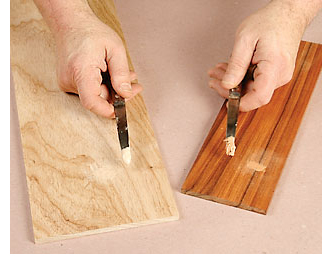
I’m refinishing a table with lots of putty-filled holes, and they are coming out much lighter after staining. How can I make them match?
Greg Williams: You can use any of a number of coloring products to darken them. A few examples are glaze, touchup markers, touchup powders, and Mohawk Blendal Sticks”.
Andy Rae: You can paint the repairs to match. In a pinch, black and brown permanent markers often do the trick, especially if you smear ’em around a little bit with your finger before they dry. For a first-rate, fool-even-the-other-woodworkers effect, go get a fine bristle brush, the kind sold at art supply stores, and mix up a few colors that best match the surrounding wood. You can use tinted dyes mixed with a drying oil or varnish finish, or do as I do: Use artists’ oils, which come in an astounding array of brown and other wood tones, are light-fast, and are easy to mix together into the precise colors you need. Be sure to mix the oil colors with Japan dryer or a varnish, such as Waterlox, so your repair will dry overnight. Paint a lighter base color on first, then use darker colors and the tip of the brush to create fine “grain” lines that connect with the grain of the surrounding area. Let the repairs dry thoroughly, then apply a couple of coats of your favorite finish on the entire piece.
Michael Dresdner: In addition to the above suggestions, you can also do touchups using a fine artist’s brush paired with those small squeeze bottles of waterbased acrylic paint you find in all craft stores. They come in every imaginable color, and can be mixed to create even more colors.
Tim Inman: “Stipple” the spots in. Get a small round brush and some acrylic artist’s media in the correct colors. Then don’t “paint” with a stroke, but spot apply by moving the brush straight up and down directly over the filler to leave small dots of color.





